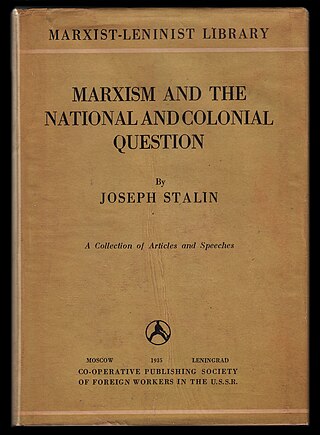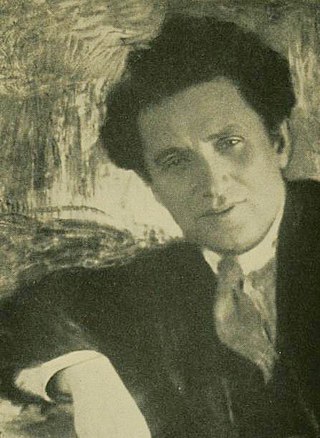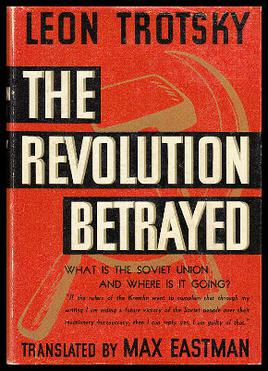
Lev Davidovich Bronstein, better known as Leon Trotsky, was a Russian revolutionary, politician, journalist and political theorist. He was a central figure in the establishment of Soviet Russia and the Soviet Union. Ideologically a Marxist, Trotsky's writings and thought inspired a major school of the ideology known as Trotskyism.

Leninism is a political ideology developed by Russian Marxist revolutionary Vladimir Lenin that proposes the establishment of the dictatorship of the proletariat led by a revolutionary vanguard party as the political prelude to the establishment of communism. The function of the Leninist vanguard party is to provide the working classes with the political consciousness and revolutionary leadership necessary to depose capitalism.
Marxism–Leninism is a communist ideology that was the predominant branch of the communist movement throughout the 20th century. Developed in Russia by the Bolsheviks, it was the state ideology of the Soviet Union, Soviet satellite states in the Eastern Bloc, and various countries in the Non-Aligned Movement and Third World during the Cold War, as well as the Communist International after Bolshevisation. Today, Marxism–Leninism is the ideology of the ruling parties of China, Cuba, Laos and Vietnam, as well as many other Communist parties. The state ideology of North Korea is derived from Marxism–Leninism. Marxist–Leninist states are commonly referred to as "communist states" by Western academics. Marxist–Leninists reject anarchism and left communism, as well as reformist socialism and social democracy. They oppose fascism and liberal democracy, and are self-proclaimed anti-imperialists. Marxism–Leninism holds that a two-stage communist revolution is needed to replace capitalism. A vanguard party, organized through democratic centralism, would seize power on behalf of the proletariat and establish a one-party socialist state, called the dictatorship of the proletariat. The state would control the means of production, suppress opposition, counter-revolution, and the bourgeoisie, and promote Soviet collectivism, to pave the way for an eventual communist society that would be classless and stateless.

Nikolai Ivanovich Bukharin was a Russian revolutionary, politician, and Marxist theorist. A prolific author on economic theory, Bukharin was a prominent Bolshevik and was active in the leadership of the Communist Party of the Soviet Union from 1917 until his purge in the 1930s.

Trotskyism is the political ideology and branch of Marxism developed by Russian revolutionary Leon Trotsky and some other members of the Left Opposition and Fourth International. Trotsky described himself as an orthodox Marxist, a revolutionary Marxist, and a Bolshevik–Leninist as well as a follower of Marx, Engels, Vladimir Lenin, Karl Liebknecht, and Rosa Luxemburg. He supported founding a vanguard party of the proletariat, proletarian internationalism, and a dictatorship of the proletariat based on working-class self-emancipation and mass democracy. Trotskyists are critical of Stalinism as they oppose Joseph Stalin's theory of socialism in one country in favour of Trotsky's theory of permanent revolution. Trotskyists criticize the bureaucracy and anti-democratic current developed in the Soviet Union under Stalin.
The history of the Communist Party of the Soviet Union was generally perceived as covering that of the Bolshevik faction of the Russian Social Democratic Labour Party from which it evolved. The date 1912 is often identified as the time of the formation of the Communist Party of the Soviet Union as a distinct party, and its history since then can roughly be divided into the following periods:
The United Opposition was a group formed in the All-Union Communist Party (Bolsheviks) in early 1926, when the Left Opposition led by Leon Trotsky, merged with the New Opposition led by Grigory Zinoviev and his close ally Lev Kamenev, in order to strengthen opposition against the Joseph Stalin led Centre. The United Opposition demanded, among other things, greater freedom of expression within the Communist Party, the dismantling of the New Economic Policy (NEP), more development of heavy industry, and less bureaucracy. The group was effectively destroyed by Stalin’s majority by the end of 1927, having had only limited success.
The 13th Congress of the Russian Communist Party (Bolsheviks) was held during 23–31 May 1924 in Moscow. Of the delegates attending, 748 had voting rights, and 416 had consultative rights. The congress elected the 13th Central Committee.

The 14th Congress of the All-Union Communist Party (Bolsheviks) was held during 18–31 December 1925 in Moscow. The congress elected the 14th Central Committee. The congress is best remembered for its declaration of intent to pursue rapid industrialisation of the Soviet Union rather than seeking lasting accommodation as an agricultural producer within the international system of capitalist world economy. It also marked the victory of the majority faction of Joseph Stalin and Nikolai Bukharin over the "New Opposition" headed by Grigory Zinoviev and Lev Kamenev.
Censorship of images was widespread in the Soviet Union. Visual censorship was exploited in a political context, particularly during the political purges of Joseph Stalin, where the Soviet government attempted to erase some of the purged figures from Soviet history, and took measures which included altering images and destroying film. The USSR curtailed access to pornography, which was specifically prohibited by Soviet law.

The ideology of the Communist Party of the Soviet Union (CPSU) was Bolshevist Marxism–Leninism, an ideology of a centralised command economy with a vanguardist one-party state to realize the dictatorship of the proletariat. The Soviet Union's ideological commitment to achieving communism included the development of socialism in one country and peaceful coexistence with capitalist countries while engaging in anti-imperialism to defend the international proletariat, combat capitalism and promote the goals of communism. The state ideology of the Soviet Union—and thus Marxism–Leninism—derived and developed from the theories, policies and political praxis of Lenin and Stalin.

Joseph Stalin started his career as a radical student, becoming an influential member and eventually the leader of the Bolshevik faction of the Russian Social Democratic Labour Party. He served as the General Secretary of the Central Committee of the Communist Party of the Soviet Union from 1922 until his death in 1953.

Marxism and the National Question is a short work of Marxist theory written by Joseph Stalin in January 1913 while living in Vienna. First published as a pamphlet and frequently reprinted, the essay by the ethnic Georgian Stalin was regarded as a seminal contribution to Marxist analysis of the nature of nationality and helped to establish his reputation as an expert on the topic. Stalin would later become the first People's Commissar of Nationalities following the victory of the Bolshevik Party in the October Revolution of 1917.

Grigory Yevseyevich Zinoviev was a Russian revolutionary and politician. An Old Bolshevik, Zinoviev was a prominent figure in the leadership of the early Soviet Union, and served as chairman of the Communist International (Comintern) from 1919 to 1926.

Lev Borisovich Kamenev was a Bolshevik revolutionary and a prominent Soviet politician.

The Revolution Betrayed: What Is the Soviet Union and Where Is It Going? is a book published in 1936 by the exiled Soviet Bolshevik leader Leon Trotsky. This work analyzed and criticized the course of historical development in the Soviet Union following the death of Vladimir Lenin in 1924 and is regarded as Trotsky's primary work dealing with the nature of Stalinism. The book was written by Trotsky during his exile in Norway and was originally translated into Spanish by Victor Serge. The most widely available English translation is by Max Eastman.
Socialism in one country was a Soviet state policy to strengthen socialism within the country rather than socialism globally. Given the defeats of the 1917–1923 European communist revolutions, Joseph Stalin encouraged the theory of the possibility of constructing socialism in the Soviet Union. The theory was eventually adopted as Soviet state policy.
Orthodox Marxism is the body of Marxist thought which emerged after the death of Karl Marx and Friedrich Engels in the late 19th century, expressed in its primary form by Karl Kautsky. Kautsky's views of Marxism dominated the European Marxist movement for two decades, and orthodox Marxism was the official philosophy of the majority of the socialist movement as represented in the Second International until the First World War in 1914, which caused Kautsky's influence to wane and brought to prominence the alternative orthodoxy of Vladimir Lenin. Orthodox Marxism aimed to simplify, codify and systematize Marxist method and theory by clarifying perceived ambiguities and contradictions in classical Marxism.
Permanent revolution is the strategy of a revolutionary class pursuing its own interests independently and without compromise or alliance with opposing sections of society. As a term within Marxist theory, it was first coined by Karl Marx and Friedrich Engels as early as 1850, but since then it has been used to refer to different concepts by different theorists, most notably Leon Trotsky.

The Permanent Revolution and Results and Prospects is a 1930 book published by Bolshevik-Soviet politician and former head of The Red Army Leon Trotsky. It was first published by the Left Opposition in the Russian language in Germany in 1930. The book was translated into English by John G. Wright and published by New Park Publications in 1931.












